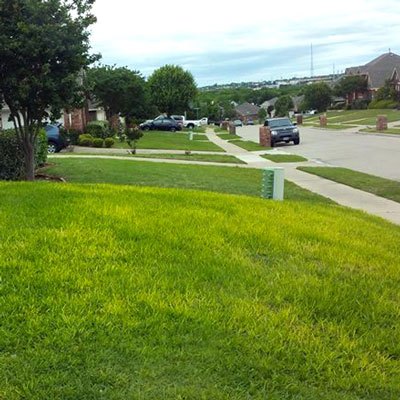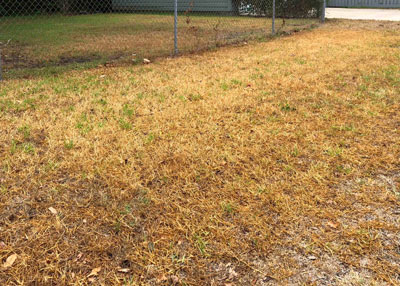Question of the Week – Number 1: January 24, 2019
“I had a terrible time with my St. Augustine last year. Is there anything I can be doing now in late winter to prepare it for TARR and chinch bugs in 2019?”
The short-form answer to this question that I’ve been asked probably 15 times in the past two weeks is “No.” There is no preventive treatment or practice you can use to slow or stop these problems for this year.

This is what I mean when I refer to the grass turning yellow in “washes.” The affected St. Augustine is severely infected with TARR.
Take all root rot (TARR) will show up earlier than chinch bugs. We’ll all find out together by the end of March if 2019 is going to be another banner year for this comparatively new disease. If so, turf will be yellowed in irregular washes across our lawns, but adding nitrogen won’t help. When we pull on the grass, runners and blades will come loose together (as they do with grub worm damage) and roots will be dried, dark and very short. It will look like grub worm damage, but grubs won’t be present in the soil.
That will be the time to apply a 1-inch layer of sphagnum peat moss to create an acidic layer on top of the soil’s surface. But remember: That’s only for TARR, and it’s only if it’s been detected and confirmed, and it’s only if we still have no reliable garden chemical that will help control the disease. As things shut down last fall it sounded like there might be some hope along those lines. I will follow up on that in the next month, and I will post a pre-season TARR report here in e-gardens. But for now, no call to action.

I took this photo myself showing an entire backyard in University Park that had been devastated by chinch bugs – and it was only mid-June, 2018!
Chinch bugs arrive once it turns hot and dry. Usually that’s in mid- to late June, but last year they took the early flight and arrived almost before spring got out the door. And, they stayed way too long.
Chinch bugs show up in the same spots each year, and it’s always the hottest, sunniest parts of our yards. Grass appears green, but it doesn’t respond to watering. Once you learn the symptoms you’ll never mistake it again. But that won’t be happening for four or five months, so let’s not obsess on it now. Again, there is nothing you can do to prevent them, so spend your spring enjoying the wildflowers. Summer will come soon enough anyway.
